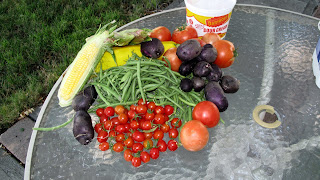

 The cast iron pot shown is said to be one of only two left in tact in the U.S. Interesting that they put sand on the ship's deck, placed the pots (notice the shape) on the sand, then lit fires under the pots to "try" the blubber. The work those men did on the 18th and 19th Century whalers is absolutely mind boggling. May I suggest Nathaniel Philbrick's In the Heart of the Sea-The Tragedy of the Whaleship Essex. This is an awesome story so very well written.
The cast iron pot shown is said to be one of only two left in tact in the U.S. Interesting that they put sand on the ship's deck, placed the pots (notice the shape) on the sand, then lit fires under the pots to "try" the blubber. The work those men did on the 18th and 19th Century whalers is absolutely mind boggling. May I suggest Nathaniel Philbrick's In the Heart of the Sea-The Tragedy of the Whaleship Essex. This is an awesome story so very well written.

 We saw as many as 13 surfers in the water at any one time. They, of course, are wearing wet suits. I talked to one of the surfers who appeared to be about 50. Says he surfs two to three times a week. In 18 months he will have his house paid off and plans to work only a few days a week, so will be able to surf more. I surfed Laguna Beach when I was 18. I remember having a really abrupt introduction to the bottom of the ocean when I missed a wave. Ouch.
We saw as many as 13 surfers in the water at any one time. They, of course, are wearing wet suits. I talked to one of the surfers who appeared to be about 50. Says he surfs two to three times a week. In 18 months he will have his house paid off and plans to work only a few days a week, so will be able to surf more. I surfed Laguna Beach when I was 18. I remember having a really abrupt introduction to the bottom of the ocean when I missed a wave. Ouch. Sonoma County is known for its wines, but the county's western border is the Pacific Ocean. J and I spent one day at Bodega Bay and tasted its reportedly great clam chowder. Now I am a clam chowder afficianado. While I can say the clam chowder at the restaurant where the movie Birds was filmed is good chowder, it is not as good as Mo's clam chowder at Newport, Oregon or other Mo's along the coast and the best chowder can be found in my sister-in-law Judy's kitchen or at Al Scoma's restaurant on Fisherman's Wharf, San Francisco. Now that is more like clam stew----lots and lots of clams. Yum, Yum, Yummmmy!
Sonoma County is known for its wines, but the county's western border is the Pacific Ocean. J and I spent one day at Bodega Bay and tasted its reportedly great clam chowder. Now I am a clam chowder afficianado. While I can say the clam chowder at the restaurant where the movie Birds was filmed is good chowder, it is not as good as Mo's clam chowder at Newport, Oregon or other Mo's along the coast and the best chowder can be found in my sister-in-law Judy's kitchen or at Al Scoma's restaurant on Fisherman's Wharf, San Francisco. Now that is more like clam stew----lots and lots of clams. Yum, Yum, Yummmmy!I will work on the wine country part in the next blog. We did tour the Charles M. Schulz Museum which was great. Could not take pictures in the museum and for some reason the pictures I took outside the museum did not record on the disc. This is a mystery. As some of you well know, Schulz was a Minnesotan and brought some of Minnesota with him to Santa Rosa by building an ice skating rink in Santa Rosa and playing ice hockey regularly. Way to go Charles. We did not have organized hockey where I grew up in Valparaiso, but we did play a sandlot variety when the city would plow out a rink each winter on Spectacle Lake. I loved playing hockey. Makes NFL look like wimps.
Note: Double click pictures for more detail.
Later, got to go rest this old body. Got lots of work to do tomorrow.
Yeeeeoooowww, Papa Coyote loves you all.



















































